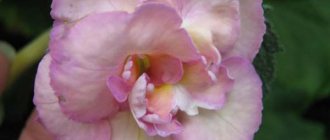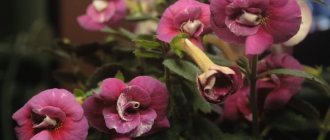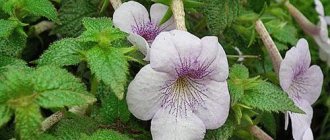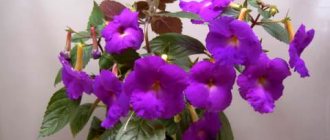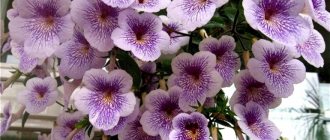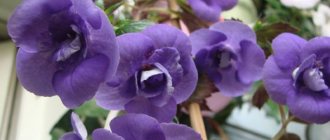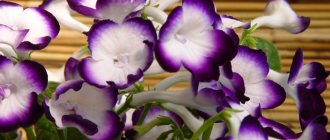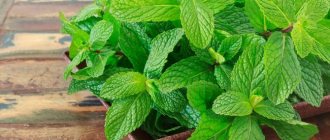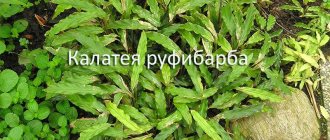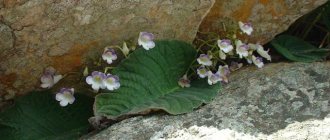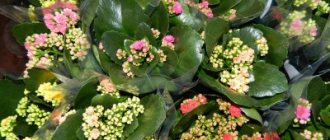According to the type of growth, Achimenes are:
- Erect.
- Ampelous.
- Semi-ampelous.
Achimenes as an indoor flower can grow both straight and in an ampel. In the first case, the branches and shoots grow upward or sideways, and in the second, on the contrary, downward, and the plant sits in special flower pots. The third option is intermediate in terms of the direction of shoot growth.
Flowerpots are flower pots of medium diameter with a special mount for hanging. Such containers are good for climbing or bushy plants. In addition, they perfectly decorate the room without taking up space on the windowsill or table.
The description of the structure of Achimenes should begin with its main advantage - flowers. In shape they are similar to a “pipe” or “gramophone” with different petals - from rounded to “torn” edges. It blooms in summer with white, yellow, pink, purple or blue flowers. There are varieties with spotted, striped or two-colored inflorescences. All appearance features vary depending on the type and variety of the plant.
Classification of Achimenes
All Achimenes are beautiful, but they are extremely heat-loving and die already at a temperature of 14 °C. It is this, as well as the need to maintain rhizomes during the dormant period in special conditions, that restrains their spread in culture.
There is no single classification of Achimenes based on external characteristics. Just like other popular representatives of the Gesneriaceae family.
Varietal and hybrid achimenosyphen are conventionally divided into groups. New cultivars are constantly appearing, which are difficult to limit within the framework of classification.
Reproduction of Achimenes
Achimenes propagates both vegetatively and by cuttings. The first method is preferable because the sprouted plant will already have a root system, which will allow further healthy lush growth and give rise to up to a dozen new rhizomes.
While propagation by cuttings allows the plant to take root only after 2-3 months and only then will they be able to form new rhizomes, which will give rise to plants only in the next season.
Large rhizomes (they look like a mulberry fruit) can be divided when planting, but not made too small so that future plants are strong and healthy.
Botanical description of Achimenes Boehme
According to the botanical description, Achimenes is classified as a member of the Gesnerieceae family. Basically, the genus is represented by perennial herbs with different appearance. Some look like shrubs, others are ampelous with creeping and climbing stems. The plant is native to South and Central America, where it grows in temperate subtropical zones. Most species are found in Mexico.
The rhizome of Achimenes is scaly and consists of rhizomes (deformed shoots). Some gardeners compare root tubers to pink light bulbs because of their similar shape. Achimenes rhizomes are excellent for vegetative propagation. When it is necessary to obtain new specimens, the root is divided into several parts and planted in new places.
The perennial stems are weak. They can be erect or drooping. The branching is weak, but this does not prevent Achimenes from creating beautiful bushes. The leaf blades, covered with small hairs, have a serrated edge. The reverse side of the sheet is painted in a bright color, for example, pink. The foliage is dense and lush, making an excellent backdrop for the tubular flowers during the flowering period.
Flowering occurs in summer. At this time, beautiful tubular buds with a spreading limb are formed. The corolla can have the most unexpected colors - yellow, blue, red, purple and others. Achimenes flowers are formed in the axils of leaf blades, one at a time or in pairs. The corolla is very large with an elegant tube and a 5-lobed cup.
Look at the Achimenes flower in the photo, which shows different forms of growing the plant in home gardens:
Achimenes Blue Swan
Achimenes Blue Swan was registered by S.Saliba in 2013 and refers to varieties of Achimenes with unchanged flower color, no matter what conditions the plant is in. Large, up to six centimeters in diameter, Achimenes flowers have a delicate blue color, which changes to a light yellow or creamy tone towards the center of the corolla. The blue flowers of Achimenes, in the photo, look spectacular against the background of dark foliage, forming beautiful cascades.
Peculiarities
Achimenes is a relative of the Uzambara violet (Saintpaulia), belonging, like it, to the Gesnerieceae family. This close relationship largely determines the similarity of the requirements of these plants for conditions of maintenance and care.
Being a representative of the tropical flora of South and Central America, this flower needs comfortable living conditions. However, during the winter dormancy period, Achimenes becomes less demanding, which greatly simplifies its care.
A characteristic feature of this plant is its specific transition to the winter dormancy phase. During this period, the above-ground part of Achimenes dies off, which causes anxiety and even panic among inexperienced gardeners.
Indeed, at first glance, drying and wilting of leaves at this stage can be mistakenly perceived as signs of plant death. However, these processes are completely natural for Achimenes.
After the death of the above-ground part, which the plant gets rid of for economical use of resources, the rhizomes (rhisomes) plunge into a dormant state. With the arrival of spring, the root system wakes up and begins to form new shoots. If you provide the plant with proper care at this time, it can please its owner with abundant flowering twice in just one season.
To date, breeders have developed many hybrid varieties of Achimenes of the most unusual colors and shades. There are varieties with simple and double, large and small flowers.
If the cultivation of indoor achimenes is carried out in accordance with all care requirements, then it enters the first flowering phase in May and can delight with its elegant appearance almost all summer. The second flowering phase usually occurs in late summer and early autumn. At this stage, the plant forms flowers of a smaller size and in small quantities, but this does not at all affect its beauty and decorativeness.
The flowers of this amazing exotic are notable for their funnel- or bell-shaped shape, variegation of colors, richness and variety of shades. The color palette of Achimenes is very extensive. It contains milky white, caramel yellow, pale and dark pink, purple, lilac, carmine red, lilac, light and dark blue tones. Achimenes with two-color striped and speckled flowers are very common in indoor plant growing.
Another important feature of these plants is their relatively long flowering time. Despite the fact that the lifespan of flowers is not very long, they are replaced in a timely manner by new buds. Thanks to this, flowering seems not only long-lasting, but almost continuous.
The most popular among gardeners are the ampelous forms of Achimenes, notable for their creeping and flowing shoots. However, this flower can be grown either erect or cascading.
Distinctive features of Achimenes
Indoor flowers Achimenes are relatives of Saintpaulia or Uzambara violet. Decorative culture belongs to the Gesneriev family. Such external similarity requires compliance with all rules for cultivation and care.
Achimenes is native to South America. This type of decorative flower prefers comfortable conditions, thanks to which it blooms profusely and quickly gains leaf mass. During dormancy, the ornamental bush reduces the level of its requirements. To do this, it is enough to water the earthen ball as it dries out.
A characteristic feature of a tropical culture is its specific transition during wintering. At this time, most of the Achimenes quickly die off the leaf mass and the entire ground part. Beginning flower growers begin to panic when such changes occur.
A houseplant, after shedding its ground part, reduces its needs. As a result, its rhizomes have time to store the necessary level of nutrients, which will allow maintaining the ideal state of the exotic crop.
In early spring, new plant parts begin to form. During this period, it is important to provide feeding in a timely manner. Mineral and organic compositions provide vibrant blooms that can be repeated twice in one season.
Breeders have managed to produce a huge number of hybrids. Each variety has its own color and flowering duration. Some varieties have ordinary but bright inflorescences. Others are decorated with terry borders or giant flowers.
Types and varieties
In nature, there are about 25-30 species of Achimenes, which to this day are successfully used by breeders to develop new original varieties. The most popular varieties and types of these plants in indoor plant growing are given below.
- Antirrhina or Entiraina (irregular form of “Antirrhina”) is a lion-headed species of Achimenes, which acquires a very spectacular appearance during the flowering period. Despite the fact that its flowering is not particularly lush, the original appearance of the flowers gives the entire plant an impressive decorative effect. The flowers are small, flounce-shaped, and have finely corrugated edges. The color of the flowers is caramel yellow with a scattering of numerous spots of wine-red color. The leaves are soft, covered with translucent hairs.
- Flava or Flava is a species of very elegant Achimenes, common in indoor plant growing. During the flowering period, the plant is covered with a few lemon-yellow bell-shaped flowers. The spectacular yellowness of the flowers looks very harmonious against the background of soft green pubescent leaves.
- Misera or Misera is a species of achimenes, notable for its creeping shoots with reddish stems. During the flowering period, it forms many small but very beautiful flowers with a light lilac or white corolla and a dark purple spot in the core.
- “Tropical Dusk” is an exclusive and very spectacular variety with medium-sized double flowers. The palette of shades is very diverse and includes caramel pink, light yellow and lavender tones. The diameter of the flowers varies from 3 to 4 centimeters.
- “Nero” is a miniature and compact varietal Achimenes with fantastic double flowers of a rich red hue. The plant is erect, has abundant emerald foliage with carved edges.
- "Sabrina" is a relatively unpretentious variety, notable for its numerous small flowers of pale ruby color and bright yellow center. The diameter of the flowers is on average about 2 centimeters.
- “Anastasia” is a medium-growing variety, characterized by its compact size and proportional formation of the bush. During the flowering period, it forms numerous small flowers of double or semi-double shape of a soft coral shade.
- “Dot” is a luxurious varietal Achimenes, rightfully loved and popular among gardeners for its abundant and long-lasting flowering. During the flowering period, it forms large funnel-shaped flowers of pale lavender color with a dark purple core. It is grown as a semi-ampelic plant, but can also take a bush form.
- “Glory” is a classic variety, notable for its very lush flowering. The simple shape of the flowers is compensated by their abundance and rich, bright ruby color. The diameter of the flowers reaches an average of 3-3.5 centimeters.
- “Nocturne” is a beautifully flowering compact variety that is widely used in indoor plant growing. The plant is notable for its abundance of emerald leaves with a pointed tip and many medium-sized, rich burgundy flowers. It is proposed for cultivation as an ampelous plant, but can also be formed as a bush.
- “Double Pink Rose” is a varietal compact Achimenes that acquires a fantastic decorative effect during the flowering period. During this period, the plant is covered with many double flowers of pale pink color, condensing towards the core. The flowers are medium in size, with petals densely collected in the center. The variety can be grown both as a bush and as an hanging plant.
Common varieties of Achimenes
Achimenes Tetra Klaus Neubner (“Tetra Klaus Neubner”)
A distinctive feature of this species is the lilac-violet corollas. At the same time, the edges of the petals are darker. The central part of the inflorescence is colored yellow. There is also a maroon pattern on a yellow background. The bush is compact, profusely flowering. The buds can grow up to 7 cm in diameter.
Achimenes Serge Saliba
This variety was bred by breeder Serge Salibay in 2007. Achimenes Orange Orchard and Yellow Queen were taken as the basis. The result was a compact plant with erect shoots. The color of double flowers is complex, for example, if the throat is yellow, then the edges of the petals are pink-orange or salmon. There are brown spots around the corolla.
Achimenes Yellow English Rose
A distinctive feature of this species is that its flowering resembles that of an English rose. He was bred by breeder Serge Saliba. The plant is famous for its large double yellow inflorescences, which can reach 6 cm in diameter. The petals have fringed edges.
Video Achimenes Yellow English Rose
Achimenes Purple King
The species is notable for its purplish-violet corollas and fringed petal edges. The dark green leaves of the Purple King variety are characterized by a bronze tint, and their undersides have a reddish tint. The shoots of young plants grow straight, but after a while they take on an ampelous shape. The central part of the flower is yellow. It also has dark brown flecks. Also worthy of special attention is the Purple Kimono variety, whose corollas are painted wine-purple.
Achimenez Etienne Andersson (“Etienne Anderson”)
The buds of this variety are large. The terry corolla is colored apricot-pink. On the reverse side the petals are lighter. The plant tolerates direct sunlight well. It can be grown in small flowerpots and hanging pots. The small leaves are colored green. With proper care, the bush will bloom long and profusely.
Achimenes Silvia Cagnani ("Silvia Cagnavi")
The double and semi-double petals of this species are bright pink. In the central part there is a yellow spot, on which there are red-brown inclusions. The flowers grow medium in size. The shoots of the bush are erect and elastic. In this case, the stems do not need support, since the flowers of Achimenes are light in weight. Over time, the petals become pale pink or ashen in color when exposed to sunlight.
Achimenes Rainbow Warrior
The Rainbow Warrior species is characterized by blue-violet corollas. In the central part of the large flower there is a yellow core surrounded by a light halo. The petals at the base are decorated with dark purple strokes and dots. The front side of the jagged leaf is dark green, the back side is burgundy. With proper care, the bush blooms profusely and for a long time. Erect shoots are painted dark burgundy. By the way, the name of the variety is translated as “rainbow warrior”. The diameter of the flowers reaches 6 cm.
Achimenes Abyss (“Ebis”) with photo
The inflorescences of this compact and self-branching species are of medium size. The plant is characterized by a terry blue-violet corolla and green leaves. At the same time, the underside of the petals is light. Near the throat there is a yellow core, on which there are thick brown specks. The shoots of the bush grow straight. The oblong rhizomes are painted white and burgundy.
Achimenes Nightfall
This species is characterized by double and semi-double, dark cherry petals. Both semi-double and double inflorescences can grow on the bush at the same time. The plant has erect shoots on which glossy dark green leaves grow. The name of the variety can be translated as “twilight”. With proper care, densely packed flowers grow. The maximum buds can grow up to 3 cm. With sufficient light, fertilizer and nutrition, the bushes will delight you with their excellent flowering abundantly and for a long time.
Achimenes Sauline
The flowers of this species are painted in a delicate light yellow color. The edges of the finely toothed petals are decorated with a pink border. There may be chimeric strokes on the surface of the petals. There is a bright yellow spot in the central part of the flower. The shoots of the bush are erect, but if desired, this species can be grown as an ampel. The buds grow to medium size. The shade of the petals depends on the growing conditions.
Achimenes Yellow Fever (“Yellow Fever”)
The double and semi-double petals of this species are bright yellow. In this case, the edges of the petals may be lighter, and sometimes pink. This ampelous variety is distinguished by abundant flowering. The size of the flowers reaches 3–3.5 cm. Green leaves grow to medium size. If desired, you can form beautiful cascades from the shoots. A bush of this variety needs at least two pinchings. The perennial is resistant to environmental factors. Therefore, it can be grown in almost any conditions. The large flowers resemble a rose in appearance.
Achimenes Honey Queen
The large flowers are yellow. The edges of the petals have a lilac-violet tint. A distinctive feature of the Honey Queen variety is the presence of light spots on the edges of the petals. The shoots of the bush are semi-drooping. With proper care, the bush produces abundant flowering. It is recommended to grow it in partial shade, as the variety does not tolerate direct sunlight.
Achimenes Queen of Lace
This species is characterized by terry corollas, colored in lavender. The petals are distinguished by an embossed relief surface and small teeth on the edges. This variety is easy to care for. The densely packed buds grow to medium sizes.
Achimenes Hard to Get
Achimenes Hard to Get
The Hard to Get variety is notable for its medium-sized terry burgundy and cold burgundy corollas. Around the pharynx there are yellow strokes and red-cherry spots and dots. With proper care, the bush will delight you with abundant flowering for a long time. The shoots of this variety grow straight.
Achimenes Peach Orchard "Peach Orange"
This abundantly flowering, compact plant variety is notable for its double corollas, painted in a bright peach color. The name of this species translates as “peach garden.” The flowers grow small. This perennial belongs to the hanging varieties. To obtain larger and fuller inflorescences, it is recommended to keep the bush in diffused light.
Achimenez Cytro with photo
The plant is notable for its double yellow corollas, growing up to 3.5–4 cm. At the same time, there are red strokes and spots on the edges of the petals. A compact bush with proper care branches well.
Achimenes Boehme
The diameter of double or semi-double flowers of bright pink color can reach 7 cm. The shoots of the plant are erect. White rhizomes have an oblong shape. The bush grows tall. Therefore, he needs additional support. With proper care, the perennial delights with its long and abundant flowering.
Achimenes Ivory Queen
The Ivory Queen variety is notable for its terry corollas and embossed petals, painted ivory. This hybrid has erect, self-branching shoots. With proper care, the bush blooms profusely.
Achimenes Nocturne
Terry corollas have a rare dark red color. The flowers grow up to 4.5 cm in diameter. The petals on the reverse side are painted in a light contrasting shade. Burgundy rhizomes have a cord-like shape. The variety is hanging, but if you install supports, it can be grown as a bush.
Achimenes Golden Lady
The “Golden Lady” variety has corollas painted in a soft yellow color, while the edges of the leaves have a lilac-pink tint. An additional petal may also grow from the central part. The shoots of the Golden Lady variety grow straight. The flowers are medium in size.
Achimenes Ice Tea
A distinctive feature of the Ice Tea variety is its burgundy-pink corollas, which have a peach tint in the center. The variety is also characterized by wavy petals. Lilac-violet rhizomes have an oblong shape. This hybrid plant can be grown as an ampel. The variety is characterized by abundant and long-lasting growth.
Achimenes Caprice
This compact, profusely flowering variety is notable for its petals with coarsely wavy purple edges. The core of the plant is yellow. There are strokes and dots of a rich brown color on it. An additional petal may grow from the throat. The shoots grow straight. This compact plant has green colored leaves. The oblong rhizomes are colored white and pink.
Achimenes Femme Fatale
The variety "Femm Fatal" is notable for its double blood-red corollas. The reverse side of the petals is white. The core of the flower is yellow with brown spots. Leaves are pubescent. The medium-sized leaves are colored light green.
Achimenes Lavender Fizz
The variety differs from others in its terry corollas, painted in a bright bluish-lavender color. At the same time, the underside of the petals is light. Large flowers. The petals are textured, dense, and have a lighter color on the reverse side. The shoots grow straight. The medium-sized, light green leaves have a jagged, pointed shape.
Achimenes Tamara Khorkina
The Tamara Khorkina variety is notable for its terry white corollas with pink-red tones. Color saturation changes depending on temperature. The shoots of the bush are erect. This compact variety is characterized by abundant and long-lasting flowering. The perennial needs at least two pinchings at an early stage of growth.
Achimenes Purple Triumph
A plant with lavender-purple textured petals. A feature of the “Pearl Triumph” variety is its long and abundant flowering. This species belongs to the ampelous plants. The reverse side of the green carved leaves is painted burgundy.
Achimenes Sweet and Sour
The variety is notable for its orange-peach corollas. Sometimes the petals can take on a completely orange tint. The yellow center is decorated with cherry blossom dots and streaks. Flower size is medium. The shoots of the bush grow straight. The stems are brown and the leaves are green.
Achimenes Boehme: care and cultivation
In order for the bush to develop well and bloom flowers, it is necessary to provide it with certain conditions:
| Factor | Spring Summer | Autumn winter |
| Location | Any window sills, except northern ones, with shading from the midday sun. Take it out onto the terrace or loggia. | Move to a dark, cool closet for winter rest. |
| Lighting | Bright light is needed. Variegated varieties do not tolerate direct sunlight; they need to be shaded. Varieties with dark greens can withstand short exposure to ultraviolet light. | Do not use additional lighting, rest period. |
| Temperature | +22…+23 °С | +15 °С |
| Humidity | 60-65%. You cannot spray the plant itself, only the air around it. You can also pour wet expanded clay into a tray, place a pot on top, or purchase an air humidifier. If water gets on the greens, large dark spots will appear on them. The bush will lose its decorative appearance. | |
| Watering | Abundant, every 3 days. | When the earth dries out. Produce in small portions along the edge of the pot (once a week, 2-3 tablespoons). |
| The water temperature is approximately 2° above room temperature. Make sure that there is no stagnation of moisture. Apply at the root or in a tray, avoiding contact with foliage and shoots. | ||
| Top dressing | 3-4 weeks after the sprouts appear. Subsequent ones - every 2 weeks with mineral fertilizers. | Not necessary. The bush is resting. |
Temperature
For normal development of achimenes, the temperature should not be lower than 20 °C, optimally 22-23 °C. It does not tolerate sudden changes in temperature and cold drafts. In summer, it can be taken out to the balcony only if there are no large fluctuations in daily temperature (cold nights). With the onset of autumn, before the onset of the dormant period, the temperature begins to decrease.
Soil and pot
The soil for planting Achimenes should be loose and light. To make your own soil, you can take leaf soil (3 parts), peat (1 part), sphagnum moss (1 part), coarse sand (1 part). The following substrate is also suitable for achimenes: leaf soil (2 parts), turf soil (3 parts), humus (1 part), coarse sand (1 part). Sand can be replaced with perlite (vermiculite), then the substrate will retain moisture longer.
You can add a little charcoal, mullein and shell rock to the prepared soil mixtures. Ready-made soil is used for planting ornamental flowering plants. The drainage layer should fill one third of the pot.
Achimenes has short roots, so it requires a wide, low container, since in a high pot the soil may begin to sour, which leads to rotting of the root system. For those plants that are grown as hanging plants, use hanging flowerpots.
Rest period
Achimenes has a pronounced dormant period, which lasts about five months. In mid-autumn, the plant ends flowering and growth, the foliage begins to fall and the stems dry out. At this time, stop watering and remove the rhizomes for winter storage. They can be left in the pot and lightly moistened no more than once a month.
There is another storage method: the rhizome is carefully removed from the container and placed in dry peat or sand. In this case, watering is not required. Rhizomes of Achimenes should be stored in a dry place at a temperature of ten to twelve degrees.
If for some reason Achimenes comes out of the dormant period ahead of schedule, you need to provide it with additional lighting so that the sprouts are full-fledged and will grow and bloom well in the future. To do this, you can use fluorescent lamps. And if, on the contrary, the shoots do not appear at the right time, you can awaken the rhizomes by watering them with water heated to fifty to sixty degrees.
Lighting and temperature conditions
Unlike other indoor plants, achimenes are not recommended to be placed in south-facing locations. Intense bright sunlight is permissible only before and during the budding period and subject to shading with tulle curtains. During flowering, such bright light is contraindicated. The flowering plant must be placed at some distance from the window or on a windowsill in the east or west.
But if the shoots and stem begin to stretch out, then the plant does not have enough lighting. In this case, it needs to be placed in a brighter place.
It is also important to know that Achimenes with dark leaves require much more sunlight than specimens with light green and variegated foliage.
The temperature regime also depends on the development cycles of the plant: during the dormant period the temperature should not exceed +15.18 degrees, and during flowering it should be within +22.24 degrees. But a sharp transition from warm to cooler content should not be allowed. This should be done gradually, gradually lowering the temperature. This way the flower will adapt to the cool weather, become stronger and be able to survive the winter safely.
For this purpose, it is placed in a room less warm than living rooms (balcony, veranda, loggia).
Rest period
With the onset of autumn, with the end of flowering, the plant begins to prepare for the dormant period. By this time, fertilizing the plant is stopped and watering is sharply reduced. Leaves stop growing, turn yellow and die, nutrients and moisture accumulate in the roots. When the above-ground part of the plant dries out (the roots will draw out all the useful substances from it), it must be cut off and the tubers left in a pot or placed in sand. The pot with tubers is placed in a cool, dark (14-16 degrees) place. Watering is carried out with settled warm water once a month, very carefully, along the edge of the pot, only slightly moistening the earthen ball - excess moisture can provoke premature awakening of Achimenes from sleep.
Advice! If the plant still awakens ahead of time, it should be provided with a lot of light using daylight lamps for plants - this will help the normal development of the stems.
Variety “Double Pink Rose” with a soft pink tint
Spectacular bush with ash-burgundy buds
At the end of February, the pot with rhizomes is transferred to a warmer (above 16 ° C) and bright room. If the roots were stored in sand in winter, they must be planted in pots with substrate.
Caring for Achimenes after planting
Planting a young Achimenes can be done either in a hanging pot or in a regular one. The main thing is not to choose very deep containers; forms with a larger diameter are better suited, as this will saturate the rhizome with oxygen much better. It is worth starting the procedure at the end of February or beginning of March, when the air temperature gradually increases - the cultivation will be successful.
When strong shoots are already sprouting on the rhizome, you should start preparing for planting. To do this, select the healthiest and most overgrown specimens and insert them vertically into the ground. Place the shoots evenly around the entire perimeter of the pot. For a container with a diameter of 10-11 cm - approximately 3-4 rhizomes. Fill in a layer of soil and substrate up to 3-3.5 cm thick.
After planting Achimenes, proper care is required. The most favorable temperature is +22…+24 degrees. And in terms of watering, it is necessary to carefully monitor the soil moisture, preventing it from drying out. Pour warm water over the edge of the pot at least once a week. With proper care, sprouts will appear in about 7-10 days.
If Achimenes flowers are not properly cared for, problems with their health may arise. The plant may be affected by pests and diseases:
- Leaf spotting.
- Aphid.
- Soft-bodied mites.
- Viruses.
The causes of such problems can be watering with cold water, drafts, too much soil moisture, contaminated soil, low temperature, scorching sun rays, and soil lying due to insufficient drainage. To avoid such problems, monitor the growing conditions of your pet, and then it will delight you with its colorful, stunning flowering for many years.
Reproduction
Achimenes can be propagated and grown from seeds.
Seeds are sown in February or March. To do this, use a container filled with large grains of sand. The sowing is covered with film on top and moistened through a tray. Store in a warm place, about 25°, sometimes ventilate. The first seedlings appear in a couple of weeks. As they grow, the pots need to be trimmed. After the bushes have strengthened, they need to be transplanted into a pot. We care for it in the same way as for an adult plant. Seeds can be purchased at a gardening store or collected from an existing plant.
Propagation of Achimenes by cuttings is not a very popular method. The stem is cut and the lower part is taken. It is planted in the sand and covered with a glass jar. The cuttings take root after 2 weeks, and after another 14 days they can be planted in a pot.
A common method of propagating this flower is by rhizomes, which is discussed in a separate article.
Diseases and pests
Among the pests, Achimenes is susceptible to infection by aphids, thrips and spider mites. At the first signs of their appearance, it is necessary to treat the plant with an insecticide solution.
Among the diseases the flower is affected by:
- Chlorosis, which occurs when the temperature is not maintained, improper lighting and lack of nutrients. In this case, it is necessary to optimize the conditions for keeping the plant;
- Fungal diseases, such as spotting and various rots, which can affect all parts of the plant. It is necessary to remove the affected areas and treat with a fungicide;
- Bacteriosis, for the treatment of which antibacterial drugs are used.
These diseases are quite difficult to treat, and if they are severely neglected, the plant may die completely. Therefore, it is necessary to regularly carry out preventive examinations of Achimenes and provide proper care for it. Then it will delight you with its bright, charming blooms for a long time.
This video will also help you in caring for Achimenes:
Recommendations for purchasing achimenes and its adaptation
There are many places where you can buy achimenes: from flower shops to online stores. Counters and catalogs are full of beautiful flowers. But, unfortunately, not all sellers adhere to an honest policy towards customers. More and more often we come across reports from gardeners about the death of a purchased plant for unknown reasons.
To prevent the purchase of a flowering bush from turning into disappointment, you should adhere to the following recommendations when purchasing:
- You need to buy a flowering plant only with a rhizome. Bushes without rhizomes are not viable. Blooming achimenes is not replanted. It is left in store soil until the planned replanting.
- When purchasing rhizomes in zip bags, you must open the packaging and carefully inspect the contents. Each rhizome must have a growing point. It is better not to buy roots with traces of rot and mold - most likely they will die. It is advisable to purchase already sprouted flowers.
- When purchasing seeds, you should pay attention to the date of manufacture. The fresher the seeds, the greater the likelihood of germination.
After purchase, it is advisable to treat Achimenes with any fungicide. The solution is prepared according to the section on prevention in the instructions for the drug. The best time to purchase new achimenes is spring. Flowers purchased in the fall may die during storage.
You need to understand that this indoor plant requires time to adapt. In order for the flower to quickly get used to its new place, it should be provided with more moisture, heat and light, and also feed the new settler with useful fertilizers.
